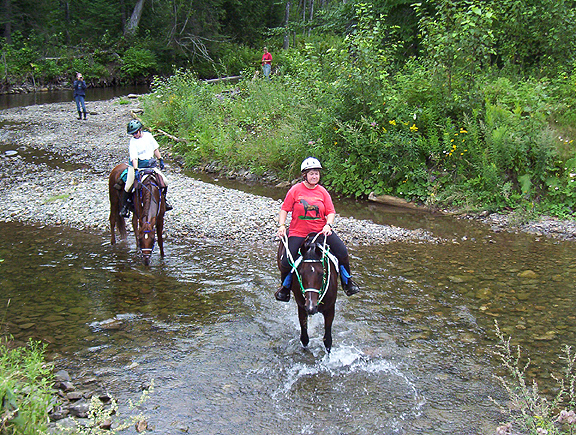Tying Your Horse
Tying Your Horse
To teach the horse to tie, it first has to know how to lead and respond to a light pull on the halter. Don't grab a half-wild colt, force a halter on, and tie him up. In the resulting terrible fight, that the frightened horse is sure to stage, delicate neck bones and ligaments will be injured, making the horse useless for the rest of his life. The horse could even kill itself in the desperate battle to free its head.
Choose a safe place to tie the horse: a strong post, a wall, or a tree with no branches that could harm the horse. Use a strong soft rope, threaded through the ring of the horse's nylon halter (nylon is stronger than a rope or leather halter), then between the front legs, loop it around the horse's barrel, and tie it with a knot that will not let the loop tighten. Tie the free end of the rope to the immovable object with a quick release knot and at about the height of the horse's withers. When the rope is tied low the horse can use a great deal of force and could injure its neck, or the horse could get his legs tangled in the slack rope when he jumps forward to relieve the pressure of the loop around his middle. Even if you do use a quick-release snap, do have a sharp knife ready, as the horse may be struggling so hard that it may not be easy to get your hands on the snap. This is one lesson that the horse has to have time to figure out for himself. Just pull up a bale of hay, a good book, and sit a spell. Stay nearby just in case your are needed.
Never tie up your young horse using a lunge line or chain lead line. The snaps on these are not very strong. Once the horse breaks one of these fragile snaps, he is well on the way to learning a dangerous habit.
When I was a student at Meredith Manor School of Horsemanship in West Virginia, I saw a horse that could not be tied with any normal rope or snap. He was big, very strong, and had a lot of experience on breaking away. This horse first had to be tied very high to a large tree, and heavy chain was used with 'U' bolts to replace snaps. The chain was threaded though the halter and around the horse's neck. At the tree, he had his lessons in tying. To make his straight stall secure, a railway tie was added to which his chain was attached. This horse obviously couldn't get loose, but it wasn't safe to be in the stall with him. You sure didn't want to be standing close to him when he threw one of his 'fits' for he put everything into his efforts to get free. While he was a great riding horse, taking him to a horse show overnight would be out of the question, if no box stalls were available.
Horses have to learn how to tie if you ever plan on using a normal horse trailer, for untied horses sometimes try to turn around in the small stalls, or fight with the next horse. What pleasure is a horse that has to be held by hand while your friends tie their mounts to the trees and enjoy themselves on a trail-ride picnic? I have been very thankful for my own horse who has spent may a long hour tied to a horse trailer at various horse shows or trail rides. Sometimes, she will just close her eyes and take a nap. I don't have to worry about her fretting or dancing about at the end of a rope.
Do remember now, all you horse loving people, to add this item to the list of things which must be taught to a young horse before it reaches its second birthday. Teach the horse to stand quietly while tied.
c)2001 by Karen Murray. All rights reserved.
Do not reproduce or redistribute any material
from this document, in whole or in part, without
written permission from Karen Murray

- Log in to post comments

Comments
Bailey! ridden by April :) I
Bailey! ridden by April :) I'm not sure what ride this is but it sure is pretty!